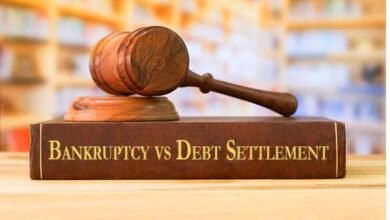Filing for Bankruptcy: A Step-by-Step Guide

Filing for Bankruptcy is often viewed as a financial last resort, fraught with complexities and uncertainties. However, understanding the steps involved can demystify the process and empower individuals facing overwhelming debt. This guide provides a comprehensive overview, offering a step-by-step approach to the bankruptcy journey.
Definition and Purpose
Bankruptcy is a legal process designed to relieve individuals and businesses from unmanageable debt. It aims to offer a fresh start by either liquidating assets to repay creditors (Chapter 7) or creating a manageable repayment plan (Chapter 13).
Common Reasons for Filing
Individuals typically file for bankruptcy due to job loss, medical expenses, divorce, or unforeseen financial crises. Recognizing the common triggers can help individuals assess if bankruptcy is the right option for them.
Types of Bankruptcy
Chapter 7
Eligibility Criteria
Chapter 7 bankruptcy is available to individuals and businesses with limited income and assets. Understanding the eligibility criteria is crucial before pursuing this option.
Liquidation Process
This section details the liquidation process, where non-exempt assets are sold to repay creditors. Exemptions vary by state, and a thorough understanding is necessary to protect essential assets.
Chapter 13
Eligibility Criteria
Chapter 13 is a reorganization plan for individuals with a regular income. Exploring this option’s eligibility criteria and benefits is essential for those seeking to retain their assets.
Repayment Plan
Detailing creating a court-approved repayment plan, Chapter 13 allows individuals to pay back debts over a specified period, providing a more structured approach.
Understanding Bankruptcy Laws
Legal Requirements
Navigating the intricacies of bankruptcy laws requires a clear understanding of the legal requirements involved. This section provides insights into the key aspects individuals must consider.
Role of Bankruptcy Courts
Bankruptcy courts play a vital role in overseeing the process, ensuring fairness, and adjudicating disputes. Understanding their function is fundamental to a successful bankruptcy filing.
Preparing for Bankruptcy
Assessing Financial Situation
Before filing for bankruptcy, a comprehensive assessment of one’s financial situation is necessary. This involves evaluating income, expenses, assets, and debts to determine the most suitable action.
Gathering Required Documents
Bankruptcy filings require a substantial amount of documentation. Ensuring all necessary paperwork is gathered and organized is crucial to a smooth filing process.
Hiring a Bankruptcy Attorney
Importance of Legal Representation
While individuals can file for bankruptcy without an attorney, having legal representation significantly increases the likelihood of a successful outcome. This section explores the benefits of hiring a bankruptcy attorney.
How to Choose the Right Attorney
Selecting the right attorney involves considering experience, expertise, and communication. Practical tips for choosing a suitable bankruptcy attorney are provided.
Filling Out Bankruptcy Forms
Detailed Overview of Forms
Bankruptcy forms can be overwhelming, but a detailed overview simplifies the process. This section breaks down common records, providing insights into their purpose and completion.
Common Mistakes to Avoid
Understanding common mistakes made during the filing process is essential to avoid delays and complications. Tips for avoiding these pitfalls are outlined.
Automatic Stay
Immediate Protection
An automatic stay is issued upon filing for bankruptcy, providing immediate protection from creditor actions, such as foreclosure or wage garnishment.
Impact on Creditors
Exploring the impact of the automatic stay on creditors, this section highlights how it levels the playing field and allows individuals breathing room to address their financial situation.
Credit Counseling
Mandatory Requirement
Credit counselling is a mandatory step in the bankruptcy process. This section delves into the requirements and benefits of undergoing credit counselling before filing.
Choosing an Approved Agency
Selecting an approved credit counselling agency is a crucial step. Guidance on choosing a reputable agency is provided to ensure compliance with legal requirements.
Meeting of Creditors
What to Expect
The meeting of creditors, also known as the 341 meeting, is a critical step in the bankruptcy process. This section prepares individuals for what to expect and how to navigate this meeting.
Addressing Concerns
Common concerns and questions raised during the creditors’ meeting are addressed, giving individuals the confidence to navigate this essential step.
Read More: Rebuilding After Bankruptcy: A Path to Recovery
Confirmation Hearing (Chapter 13)
Approval Process
For Chapter 13 filers, a confirmation hearing determines the approval of the repayment plan. Understanding the process and potential adjustments is crucial for a successful outcome.
Adjustments to the Repayment Plan
This section details how individuals can request adjustments to their repayment plan, ensuring it remains feasible throughout the designated period.
Discharge of Debts
Conditions for Discharge
The ultimate goal of bankruptcy is the discharge of debts. Conditions for obtaining a shot are outlined, emphasizing the importance of meeting all requirements.
Exceptions and Limitations
Certain debts may not be dischargeable. This section explores exceptions and limitations to the discharge, providing a comprehensive view of potential outcomes.
Rebuilding Credit After Bankruptcy
Importance of Rebuilding
Rebuilding credit is a crucial step post-bankruptcy. This section emphasizes the significance of rebuilding and provides actionable strategies for improving credit scores.
Strategies for Improvement
Practical tips and strategies for rebuilding credit are discussed, offering individuals a roadmap to regain financial stability and credibility.
Common Bankruptcy Myths
Debunking Misconceptions
Addressing prevalent myths surrounding bankruptcy, this section dispels misconceptions and clarifies the process’s realities.
Realities of Bankruptcy
Understanding the actual impact and consequences of bankruptcy is essential for informed decision-making. This section provides a realistic view of what individuals can expect.
Alternatives to Bankruptcy
Debt Consolidation
An overview of debt consolidation as an alternative to bankruptcy offers insights into how individuals can consolidate their debts for more manageable payments.
Negotiating with Creditors
Negotiating with creditors can be an effective strategy to avoid bankruptcy. This section explores the negotiation process and potential outcomes.
Read More: Bankruptcy vs. Debt Settlement: Pros and Cons
Conclusion
In conclusion, filing for bankruptcy is a complex but navigable process. By understanding the intricacies, seeking professional guidance, and taking proactive steps to rebuild, individuals can embark on a journey toward financial freedom and a fresh start.
FAQs(Filing for Bankruptcy)
Is bankruptcy my only option if I have significant debt?
Bankruptcy is one option, but alternatives like debt consolidation or negotiating with creditors should be explored before deciding.
How long does the bankruptcy process typically take?
The duration varies, but Chapter 7 usually takes a few months, while Chapter 13 may last three to five years.
Can I keep any assets if I file for Chapter 7 bankruptcy?
Certain assets may be exempt, allowing individuals to retain them. Consultation with a bankruptcy attorney is crucial for understanding specific exemptions.
Will bankruptcy ruin my credit forever?
While it has a significant impact, individuals can start rebuilding their credit immediately after bankruptcy, and improvements can be seen over time.
Can I file for bankruptcy without an attorney?
Yes, it’s possible, but having an experienced bankruptcy attorney dramatically enhances the chances of a successful outcome.












2 Comments